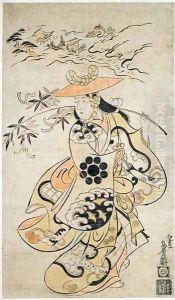Kiyonobu I Torii Paintings
Kiyonobu I Torii was a prominent Japanese artist and printmaker of the Edo period, known for his significant contributions to the development of the ukiyo-e genre of woodblock prints. Born in 1664, he was the founder of the Torii school, which played a crucial role in the evolution of Japanese theatre-related prints.
Kiyonobu was originally from Edo (present-day Tokyo), and his family had a connection with the Kabuki theaters as creators of theater billboards, a relationship that deeply influenced his artistic career. Kiyonobu's works often depicted subjects related to Kabuki, such as actors, theater scenes, and play advertisements. This particular focus made the Torii school's style distinct, as it was characterized by bold lines, vivid colors, and dramatic compositions that captured the dynamism of the Kabuki stage.
Throughout his career, Kiyonobu worked on various types of ukiyo-e prints, including single-sheet prints, actor portraits, and illustrated books (ehon). His style was instrumental in shaping the yakusha-e (actor prints) genre, which would later be further developed by his successors in the Torii school. Kiyonobu's prints not only served as a form of popular entertainment but also as a means of promoting the Kabuki theater and its actors.
Kiyonobu's contribution to the ukiyo-e movement extended beyond his own works. He played a vital role in establishing the visual language that would come to define the genre, influencing subsequent generations of artists. His legacy was carried on by his son, Kiyonobu II, and other members of the Torii school, which remained active in the production of ukiyo-e prints for over two centuries.
Kiyonobu I Torii passed away in 1729. Despite his death, the impact of his artistic innovations continued to resonate throughout the Edo period and beyond, securing his place as a significant figure in the history of Japanese art.
